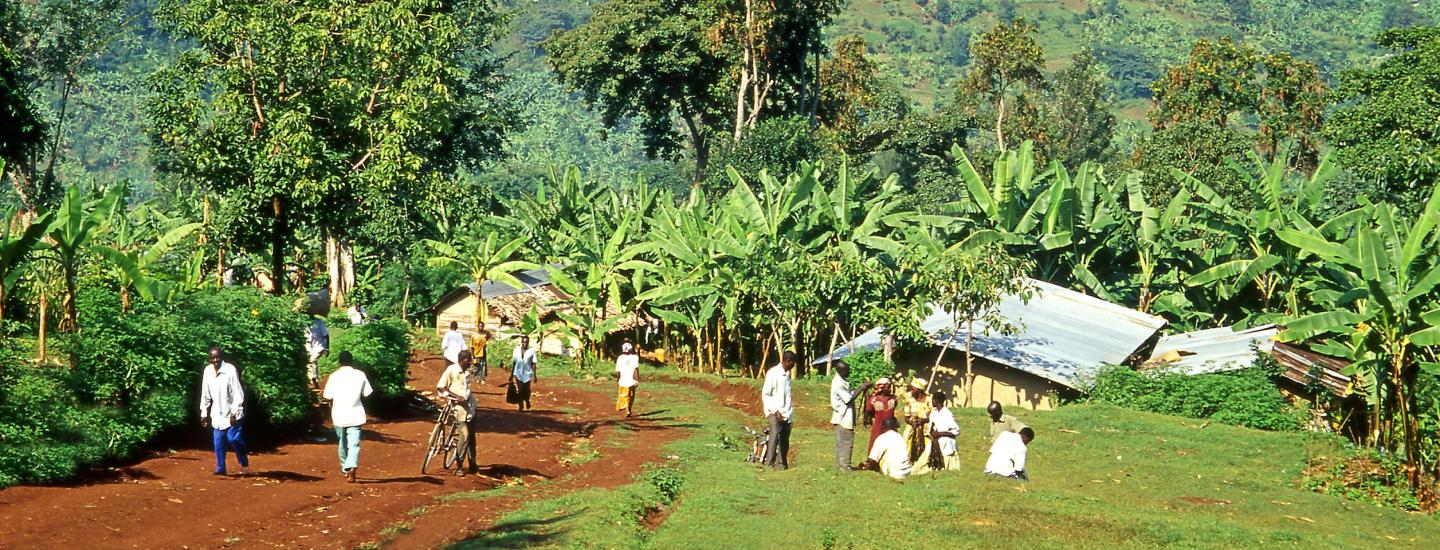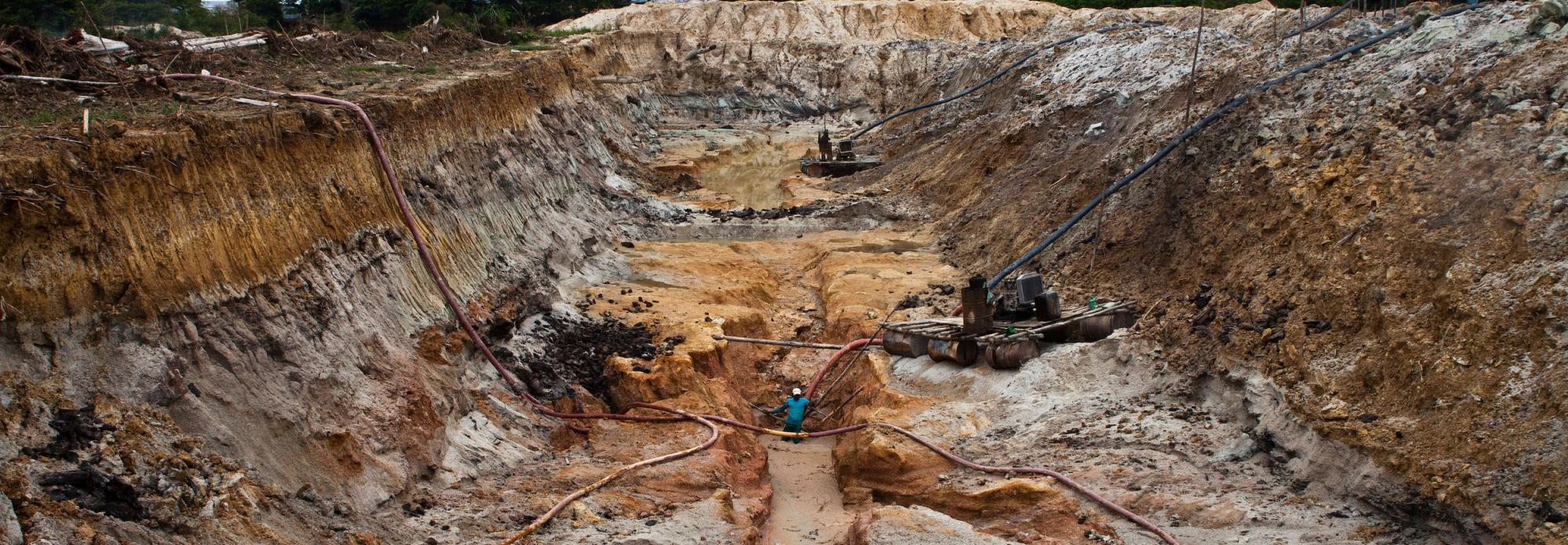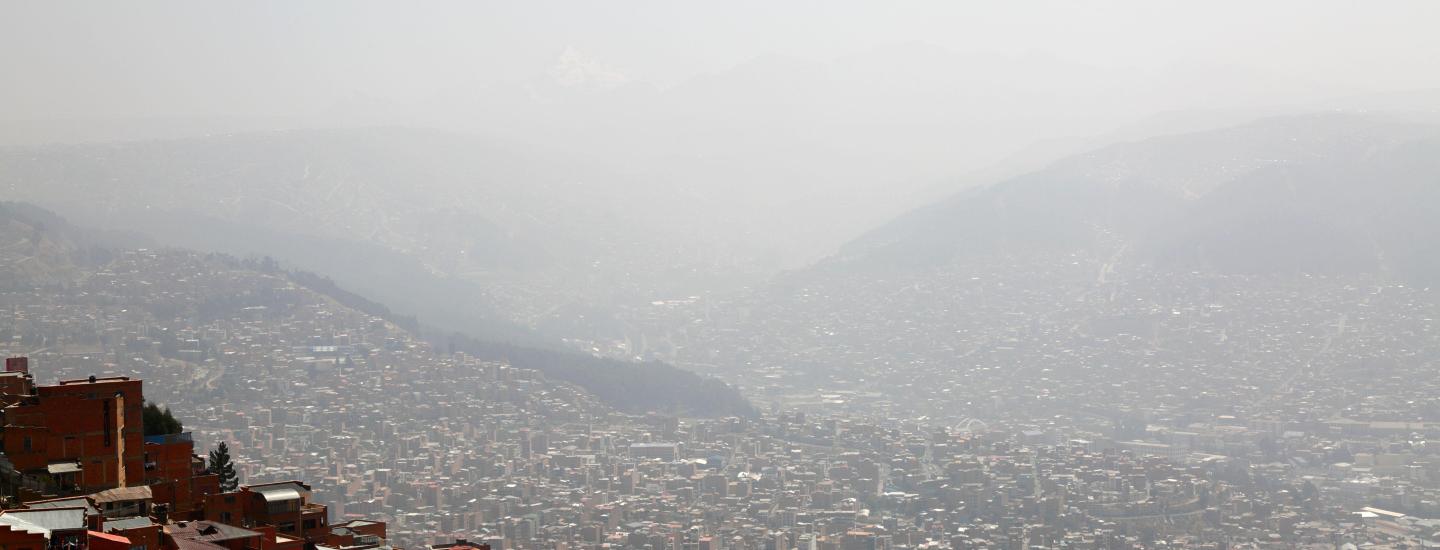- Forest Insights
The Commodity Report: Soy Production’s Impact on Forests in South America
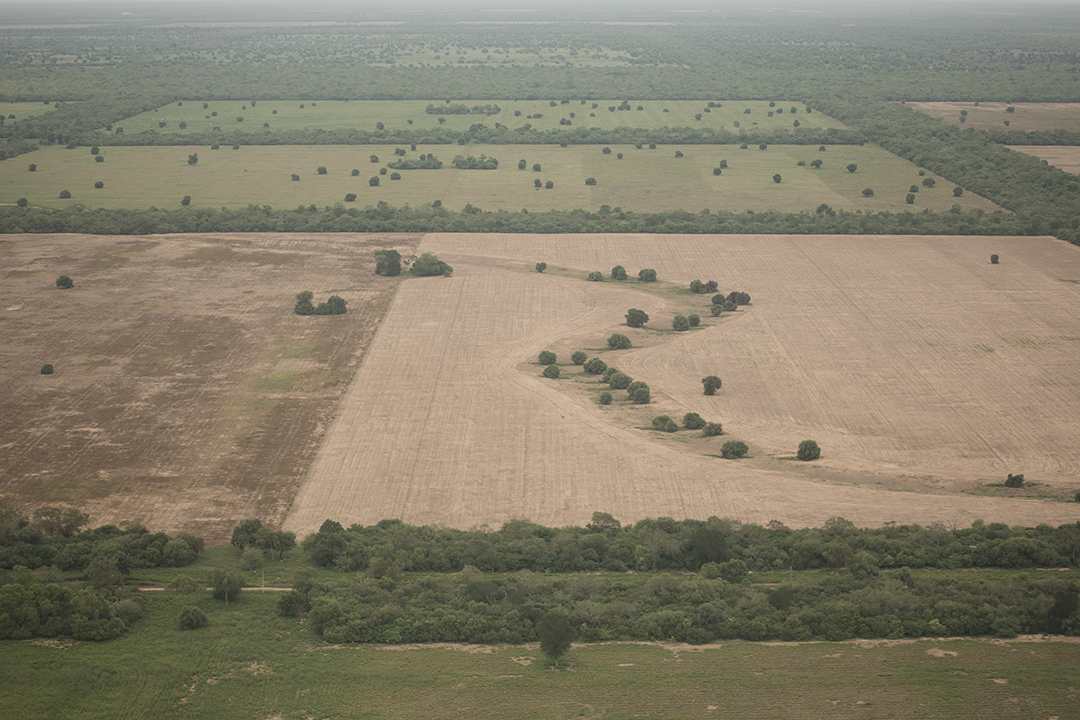
The reach of deforestation and the uses of land for agribusiness are seen from an airplane near the city of Filadelfia.
-Jordi Ruiz Cirera
As global food demand increases so too does the potential destruction of natural ecosystems to accommodate growing commodity production. Understanding deforestation related to agriculture is essential to developing strategies that solve these challenges. Recent research from World Resources Institute shows that 8.2 million hectares of forest were replaced by soy between 2001-2015 globally, of which 7.9 million hectares of conversion occurred in South America. Soy is also grown in large quantities in the United States, China and India, but in South America production is expanding into forests, threatening important ecosystems.
New data from Texas Tech University and University of Maryland, available on GFW and GFW Pro, enables anyone to see the extent of soy production within South America at a 30×30-meter resolution, per harvest year, from 2000 onward. To better understand the trends of soy production on the continent’s forests, we combined the new data with annual tree cover loss data and focused only on yearly soy expansion– new areas of soy planted per year from 2001 onward.
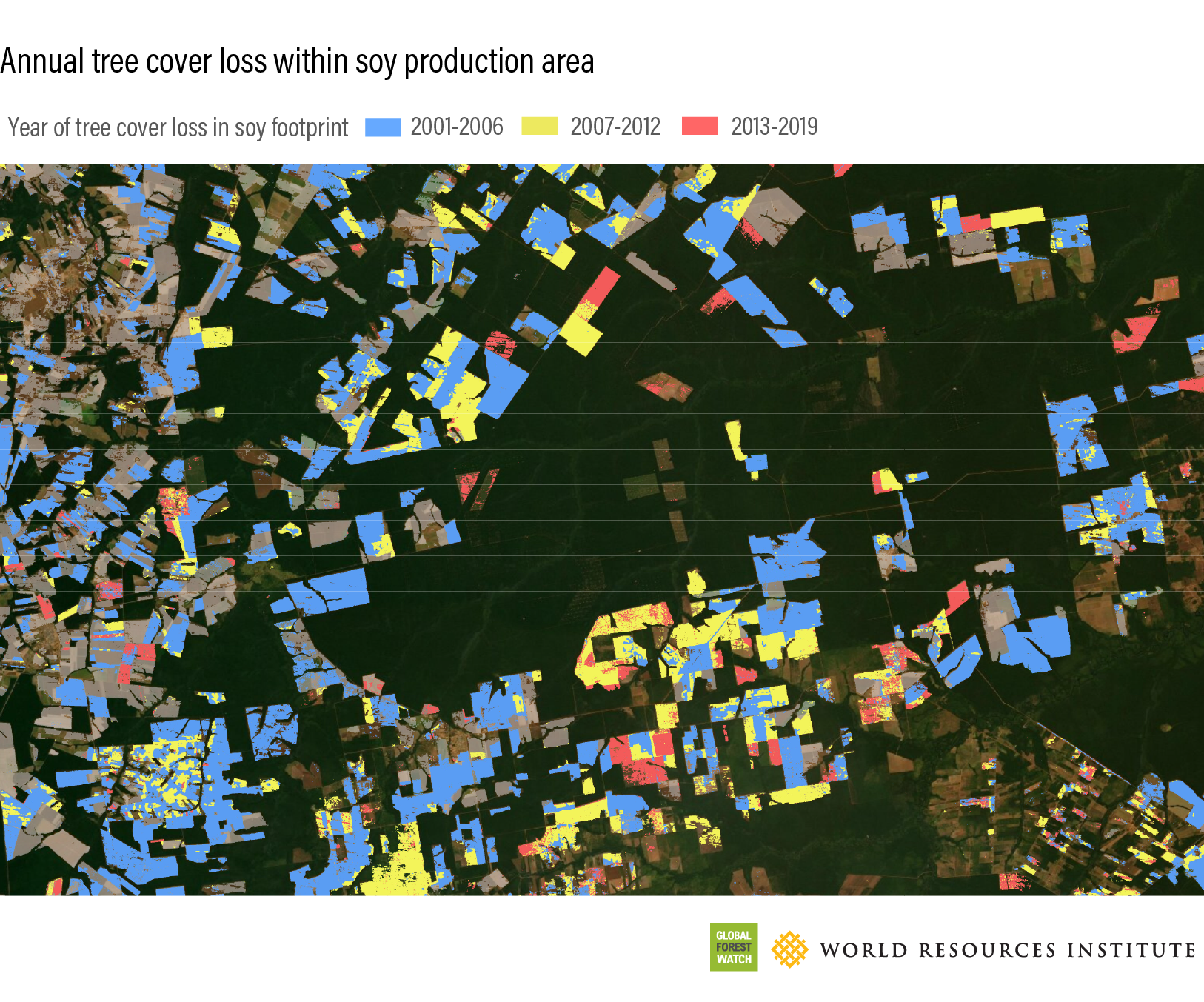
The dynamics of soy replacing forests in South America are complex because soy is often planted several years after tree cover is initially cleared. During the interim period land can be used for other purposes, typically pasture for grazing cattle. We classify the impacts of soy production as follows:
- Soy can have a direct impact on forests when land is cleared and immediately converted to soy production. We consider any forest loss that occurred three years before soy establishment as immediate conversion.
- Soy can have a delayed impact when forests are cleared and used for other purposes for several years (three or more years for our analysis) prior to soy establishment. Our previous analysis shows that between 2001-2015 in South America, soy directly converted 3.9 million hectares of forest and had a delayed impact on the remaining 4.0 million hectares.
- Just like any other crop, soy could also be a driver of indirect land displacement. As the area of available land is finite, land use change in one area could be indirectly linked to land use changes elsewhere. Our analysis cannot quantify the impact of indirect land displacement.
Soy Expansion Threatens Ecosystems Beyond the Brazilian Amazon
Historically, expansion of soy production in the Brazilian Amazon has faced intense public scrutiny, prompting action by both public and private sector actors. For example, Brazil’s Forest Code directs farmers in the Amazon to set aside 80% of their property as a forest reserve, and under the Soy Moratorium, traders agreed not to purchase soy grown on land cleared after 2008. However, in 2019 just 14% of all expansion across South America occurred in the Amazon. Our analysis shows that soy expansion has also impacted other important ecosystems that have received less attention.
In Brazil Forest Area Replaced by Soy in the Cerrado is Comparable to the Amazon
Situated south of the Amazon, the Cerrado is the most biodiverse savanna ecosystem in the world. Land use planning and scientific advancements during the 1980s and 1990s transformed the Cerrado into an agricultural powerhouse for soy, cattle, and other commodities at the expense of millions of hectares of forests and native vegetation. Over the last 20 years the extent of soy production in this biome has more than doubled, and in 2019 a third of the entire South American soy planted area was located in the Cerrado.
Environmental protections in the Cerrado are less strict than in the Amazon, and both biomes have experienced comparable total forest area replaced by soy over the last 20 years. Furthermore, the amount of direct forest conversion to soy in the Cerrado is almost twice as high as the Amazon, where large quantities of soy are still being planted on land where forest was cleared more than 15 years ago.
Rates of direct annual conversion have trended downward over the last several years, but delayed conversion has been relatively stable. Even if not a direct attribution, such delayed effect is relevant as studies have demonstrated that expectations of future increase in land’s value, which occurs when an area is converted to agriculture, have impacts on decisions to deforest. Even if soy does not occupy the land right after it is deforested, the expectation that it could do so in the future can also be considered a driver of deforestation.
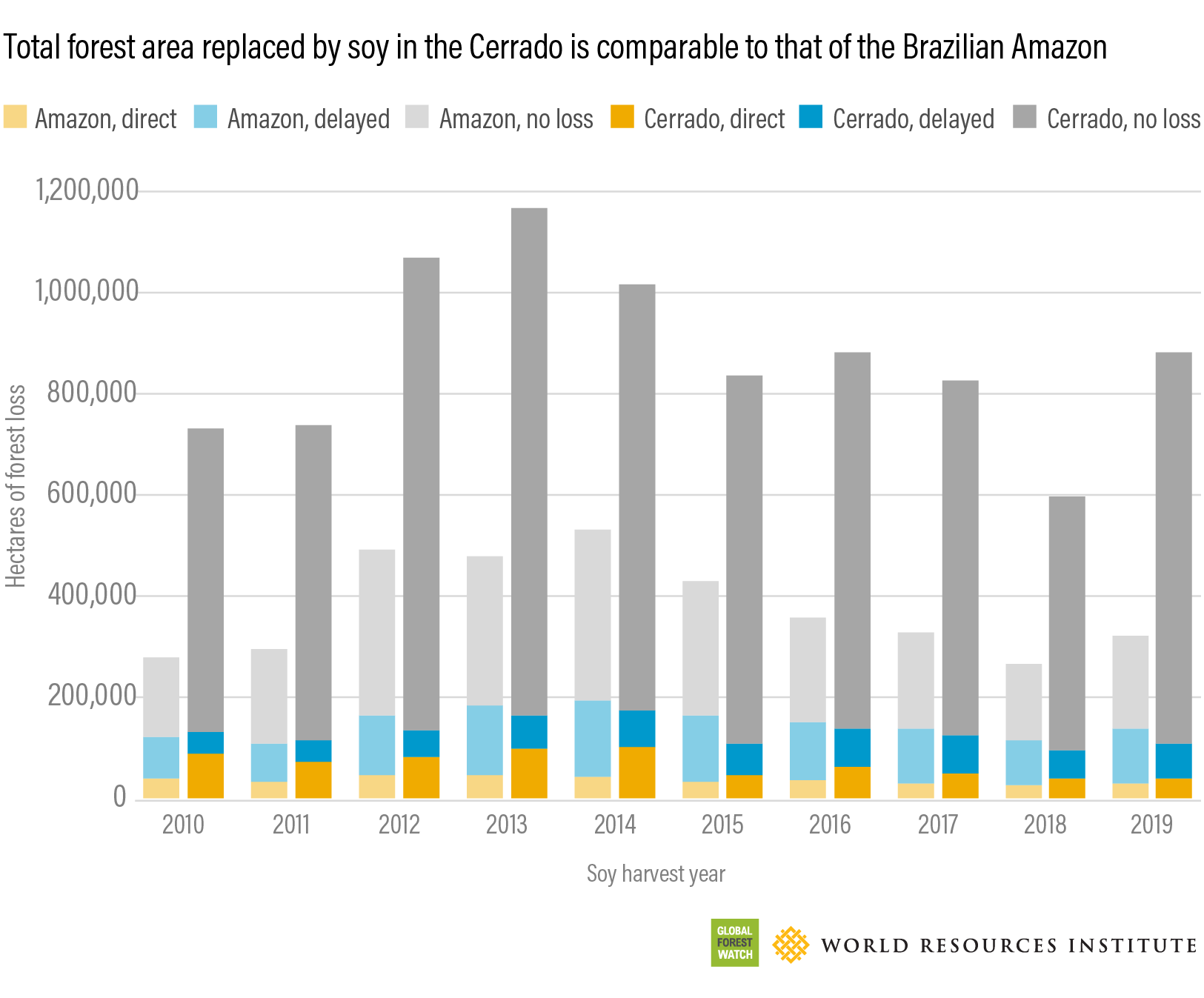 Each column represents the total area of soy expansion in each harvest year. Yellow represents the proportion of that yearly expansion taking place in areas recently deforested and blue in areas that were forested more than three years before soy expansion happened.
Each column represents the total area of soy expansion in each harvest year. Yellow represents the proportion of that yearly expansion taking place in areas recently deforested and blue in areas that were forested more than three years before soy expansion happened.Direct Conversion of Forests to Soy is Decreasing in Argentina, but Not Fast Enough
Only a very small share of soy production in Argentina has come at the expense of forests as the crop is primarily grown in the Pampas grasslands. However, due to the considerable extent of land area occupied by soy across the country, Argentina is still second to Brazil in terms of total forest area replaced by soy. Soy primarily replaced forests in the northwestern portion of the country, where soy expansion threatens forests and other native vegetation in the Gran Chaco. This highly biodiverse ecosystem is the largest dry forest in South America and a prominent frontier of agricultural expansion.
During the last ten years in Argentina the extent of forest area replaced by soy per year has more than halved, and during the same time period the area of direct conversion of forests to soy also plummeted, falling from 87,000 to 12,000 hectares in 2019. However, the declining rate of direct forest conversion has not kept pace with the declining area of overall soy expansion, which has fallen at a much faster rate.
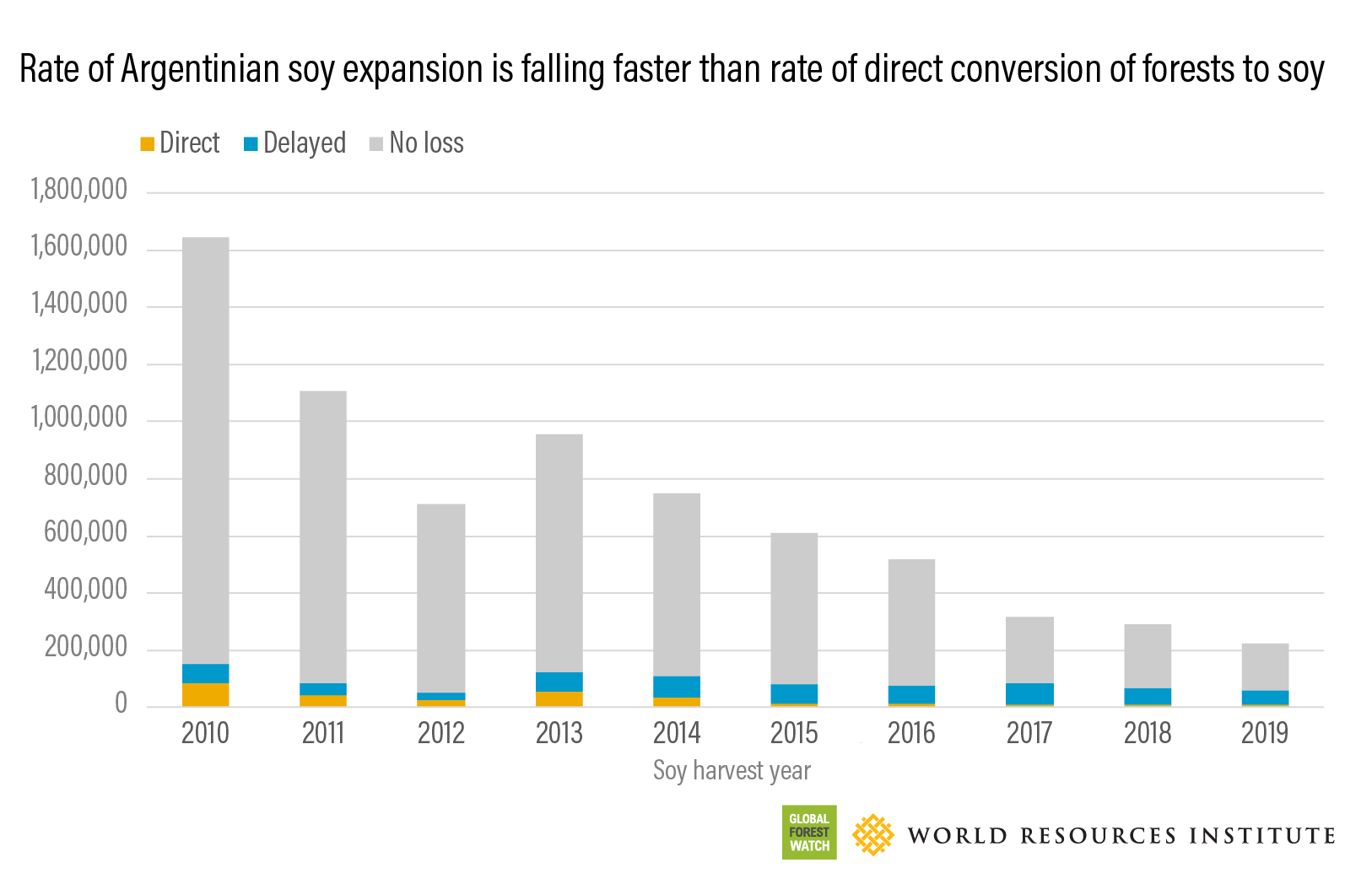
Soy Production in Paraguay Remains Concentrated in the Atlantic Forest
Paraguay is home to two key forested ecosystems: the Chaco in the west and the Atlantic Forest in the east. The Atlantic Forest is one of the most diverse ecosystems on the planet and one of the most endangered as current forest cover is only a fraction of what it once was. This biome is where soy expansion has primarily replaced forests, and our analysis shows that direct conversion of forests to soy in this biome has trended downward over the last several years, falling from a peak of 22,000 hectares in 2013 to 5,000 hectares in 2019. However, the Atlantic Forest in Paraguay is protected by a Zero Deforestation Law, passed in 2004 in response to high rates of deforestation in the early 2000s. Direct conversion of forests to soy should not be taking place in this biome at all and are, by definition, illegal.
As available land in the east shrinks, concerns about agriculture creeping into the Chaco have grown. However, our analysis found that while the area of planted soy in western Paraguay has increased over the last 20 years, overall soy production in Paraguay remains concentrated in the east, accounting for approximately 98% of all soy planted across the country in 2019. Likewise, forest area replaced by soy is concentrated in eastern Paraguay, and in 2019, 86% of forest replaced by soy in Paraguay was located in this region of the country. Soy cannot yet be considered a significant direct driver of deforestation in the Paraguayan Chaco, and conversion of forests is mainly linked to other commodities.
Soy Replacing Forest in Bolivia Creates a New Hotspot of Deforestation
Although Bolivia produces far less soy than its neighbors, the expansion of soy production is largely occurring at the expense of forests. In 2019, soy replaced 49,000 hectares of forest, accounting for 80% of the entire soy expansion area in the country. Direct pressure on forests is high as well, and during the same year, soy directly converted 22,000 hectares of forest. This area is comparable to other regions where the overall extent of soy expansion is much higher. For comparison, in 2019, 29,000 hectares of forest in the Brazilian Amazon was directly converted for soy expansion and in the Cerrado 40,000 hectares of forest was converted.
In 2020 the country was among the top ten countries for humid tropical primary forest loss. Soy is largely replacing forests in the Chiquitano Dry Forests, a unique transitionary biome situated between the Amazon and drier forests of the Chaco. If nothing changes, it’s likely that deforestation will continue to increase, placing all three biomes at risk.
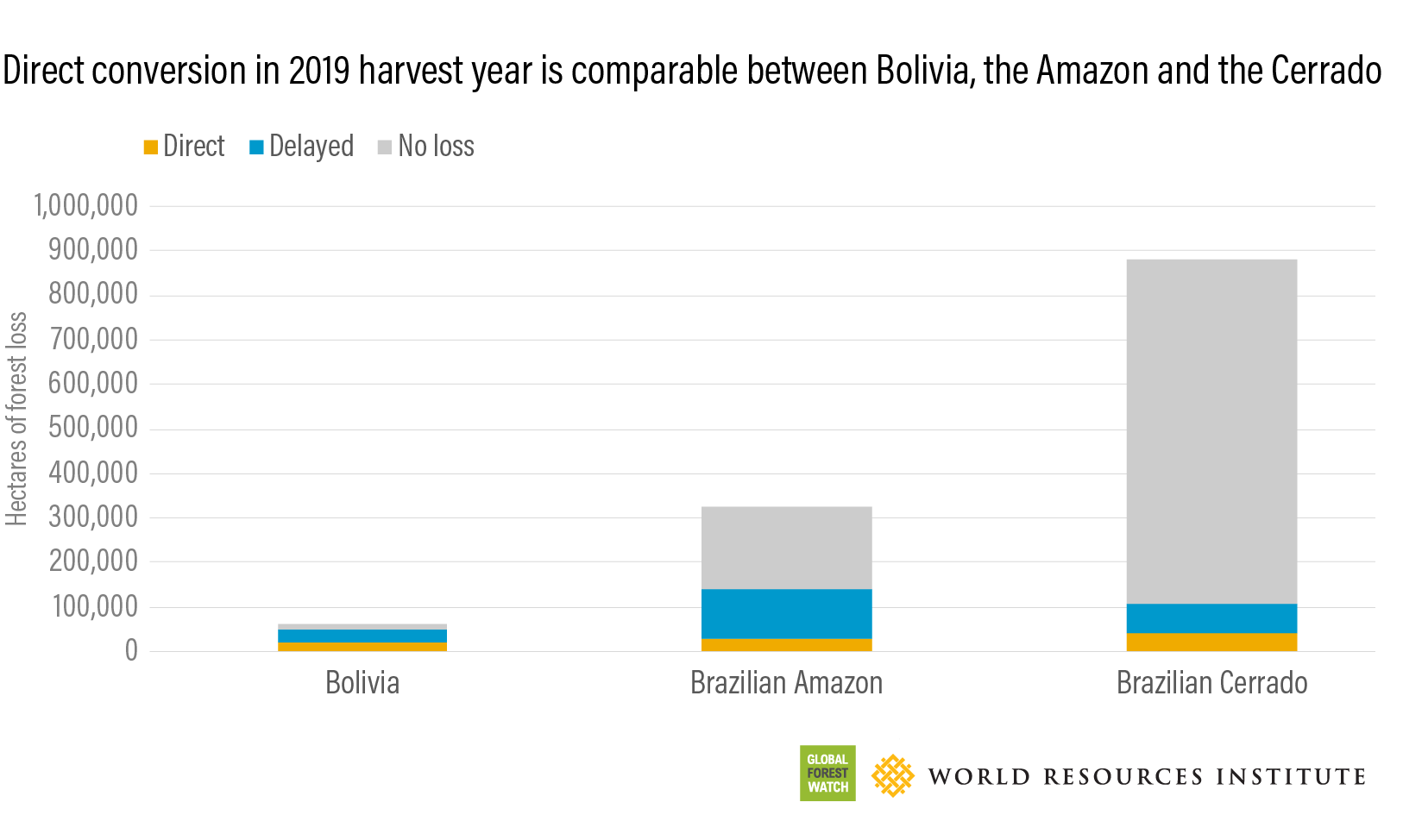
Sustainable Soy Production Will Require a Holistic Approach
Focusing sustainability efforts on a single commodity does not fully address the challenges of deforestation in South America, and the indirect impact of soy on forests may be larger than what our analysis shows because of its links to other commodities. Soy often replaces pasture because cattle grazing is typically the activity that first occupies land once forests are cleared. Between 2000 and 2015, 45.1 million hectares of forest was replaced by pasture globally, over five times that of soy. Soy is also an important source of animal feed, primarily for poultry and pork, as well as also aquaculture. Further, the value of forests areas, pasture areas and cropland changes over time, meaning that the expectation of land value increases with crop expansion is a key driver of deforestation as well.
As global demand for soy and other commodities rises, pressures for bringing more land into production will also continue. Numerous studies have confirmed that the Soy Moratorium has played a key role in reducing forest conversion to soy in the Amazon, but a prominent criticism is that it could potentially drive forest conversion to soy in other ecosystems. Likewise, Paraguay’s Deforestation Moratorium only applies to the Atlantic Forest, and, although our analysis shows that soy production in the country is concentrated in this biome, the Chaco is still a vulnerable agricultural frontier. If only the Brazilian Amazon or Paraguay’s Atlantic Forest are off limits, there is additional pressure placed on forests and other natural ecosystems.
There are several mechanisms that can help achieve sustainable production goals. Governments can tackle direct risk of land conversion by implementing and enforcing laws. Both governments and companies need to send clear policy and market signals to help end the perversive cycle of land price speculation and land grabbing. In addition, corporations should adhere to due-diligence practices when procuring suppliers (both direct and indirect) and transparently demonstrate progress over time. Finally, efforts to boost productivity of soy and other commodities on existing agricultural land should be emphasized, while also linked with ecosystem protection measures and investments in new technologies. These strategies will help meet growing global food demand and ensure economic growth in South America while preserving its forests and natural resources.
